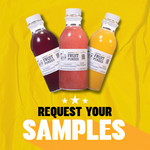With 2022 behind us, 2023 is here. Dry January is over, and typically, now is the time to ramp up and prepare for the busier drinking season. Trends in the last couple of years have made some weary for our future. Draft sales have not yet reached pre-pandemic numbers. Large regional breweries seem to be downsizing. And the beer growth slowing down can be alarming to say the least. And although this does not seem like good news, what it has created is new opportunities, and exploration for brewers to go beyond beer. Seltzers have already made their mark, but trends are still showing a rise in many other markets such as RTDs (ready-to-drink cocktails), Hard Kombucha, NA (Non-alcoholic) beers, and value beers. Change is here for the alcohol market, and craft brewers should lean in and embrace it.
Hard Seltzer
Hard Seltzer is no stranger to the craft brewing world. The trend has been around for quite a few years now, and its here to stay. It also seems to be the easiest beverage beyond beer for a brewery to produce. There usually isn’t any specialized equipment or ingredients. Most breweries are already producing these. And using real fruit like Aseptic Fruit Purees, can set a seltzer apart from the extract versions. Hard seltzer does not need to be artificially flavored alcohol juice.
RTDs
RTD stands for Ready-to-Drink. This can include Hard Seltzers, but can also include canned or pre-packaged cocktails, and spirits based drinks. The market here seems endless. Its not just about fruiting a bit of sugar water. Ginger Lime Vodka Soda, or Cinnamon Mocha Latte Malt Beverage. You name it and there are consumers out there drinking it. The range in which RTDs can go is so vast. Obviously with spirits based RTDs, there is separate equipment and licensing needed. But, as this market grows, it doesn’t seem like the consumer cares if the base is fermented sugar, malt, or distilled spirits. Craft brewers already have what they need. 2023 will not have a shortage of RTDs and as the shelf space expands for this category, more brewers will have the opportunity to get their products out there. In the meantime, RTDs should not be slept on, this is not a fad like the Brut IPA. Hop on this train before you end up behind.
Hard Kombucha
Hard Kombucha is expected to grow 500% in the next 10 years. And although some regional sized breweries are downsizing, others are expanding production facilities to handle products like Hard Kombucha that go beyond beer. It could be the fact that many consumers are now more health conscience. Maybe the tastes of the newer generations want a fruity alternative to beer. The versatility of this drink makes it a great substitute for beer, wine, and cocktails. Typically, its low carb, low sugar, and expected to use all real ingredients. This is definitely a beverage that the consumer expects real fruit be used and not “natural” and artificial flavorings. The base of Hard Kombucha lends itself well to fruit. Ginger Lemon Kombucha hits on the nose of what’s expected but a Prickly Pear Acai flavored probiotic tea is maybe what is needed right now in this market.
NA (Non-Alcoholic) Beers
The Non-Alcoholic beer category is something that we all made fun of for the majority of the time that its been around. And although Dry January brings more customers to the category, the demand for NA beers is going well and above the single month. With this category still skyrocketing, there still seems to be more to explore here. NA Beer is not just for macro lager anymore. Diversity is not as present, and craft brewers have room to let their minds run wild. When is the last time you saw a Banana Papaya NA Hefeweizen? Or a Peach Cobbler NA pastry Gose? The NA beer category is wide open. Its growing at insane rates. And now is the time for craft brewers to make their mark.
Inexpensive Beer
This category does not go beyond beer, but it should be mentioned as this is a trend that will be popular in 2023. With inflation rising, consumers are looking for places where their dollar goes further. Beer drinkers are looking for value and brewers need to start adding value to be competitive. Typically, we see 12-packs of lighter lager or blonde styles for the price of a 6-pack in this category. Maybe a light beer that sells for less than $4 a pint in the taproom. And a sliver of the category could also include high ABV styles at the price of lower ABV styles. This may be a 9% Belgian beer 6-pack at the same price as a 4.5% golden ale. This category for the consumer is about getting the most bang for their buck. One thing missing from this category though is flavor. Maybe we associate inexpensive with cheap and bland, but this doesn’t need to be the case. A tangerine lemongrass witbier can easily fit here. Or spicing up that 9% Belgian beer with Pineapple Aseptic Fruit Puree. Brewers can still add value and not compromise in quality and flavor.
Conclusion
2023 is already underway and the deceleration of beer sales should not get us down. As brewers, we have so much more to explore. Let’s all go beyond beer this year and thrive.
Spencer Moore
spencer.moore@lock27brewing.com
Brewing consultant






